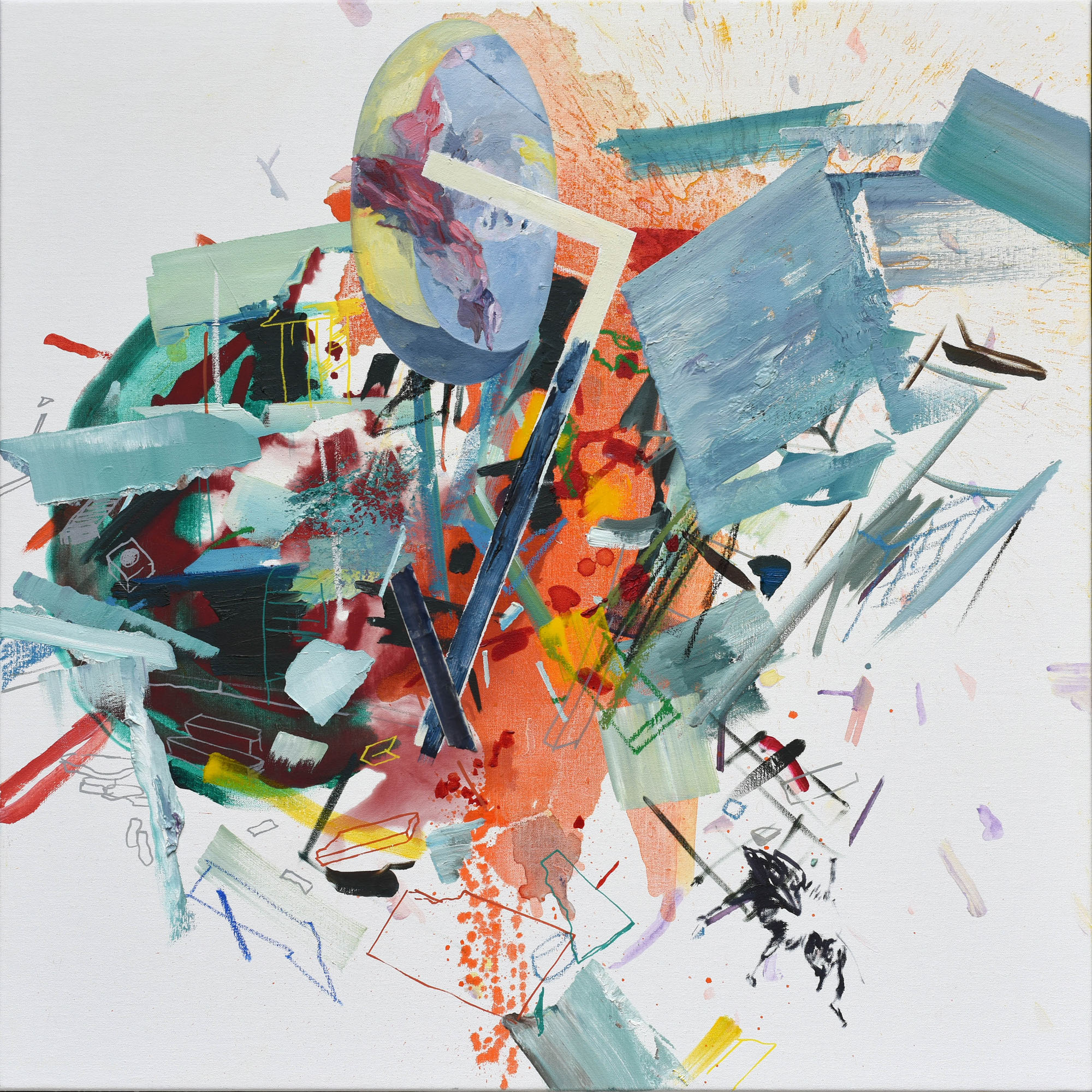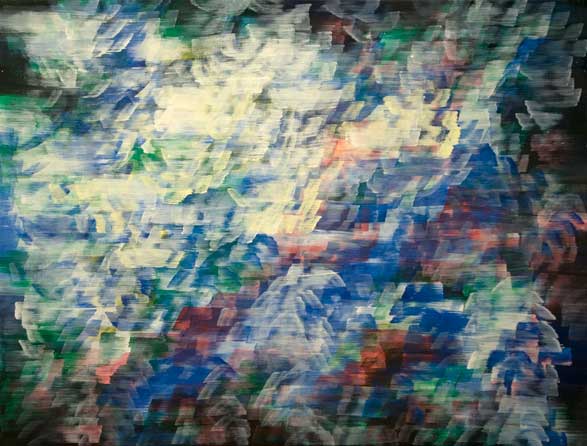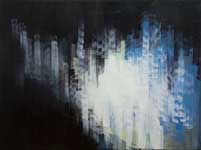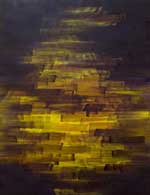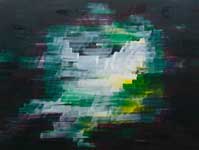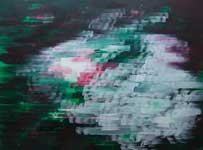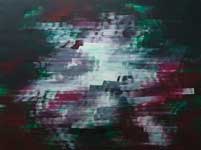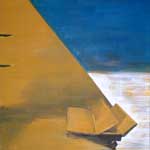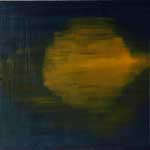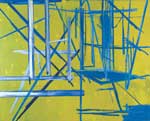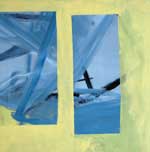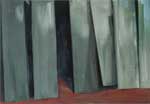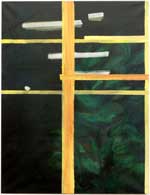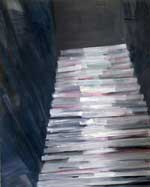zandpoortvest 10
be 2800 mechelen
t +32 15 336 336
m (b) +32 478 811 441
m (d) +32 475 477 478
Virginie Bailly
Faculty Club Leuven, until 31.12.2020
"De werken van Virginie Bailly vloeien naar eigen zeggen voort uit "de bevraging en ervaring van de omgevende ruimte" en "de vertaling daarvan in een beeld." In het spoor van de moderne traditie wapent Bailly haar blik om vat op haar omgeving te krijgen, maar tegelijk beseft ze dat ze zich als een blinde mier in een steeds complexer en onoverzichtelijker omgeving bevindt. Ze vat de creatie van haar beelden op als een dynamische, procesmatige constructie, met een aantal vaste componenten maar zonder plan, opgebouwd uit verf, kleur en de beweging waarmee die op doek gezet worden. Meestal startend van de impressie van een fotografisch beeld, begint ze een proces waarin de lichtintensiteit een centrale rol speelt en waaruit geleidelijk, in een opeenvolging van min of meer transparante lagen, in een wisselwerking tussen handelen en laten gebeuren, tussen vol en leeg, een "filter" tot stand komt: "een filter die het beeld verzacht, vertroebelt of versplintert." [Frank Maes]
Haaksheid P05, 2019, olieverf op doek, 80 x 80 cm, 4.800€
Other available works
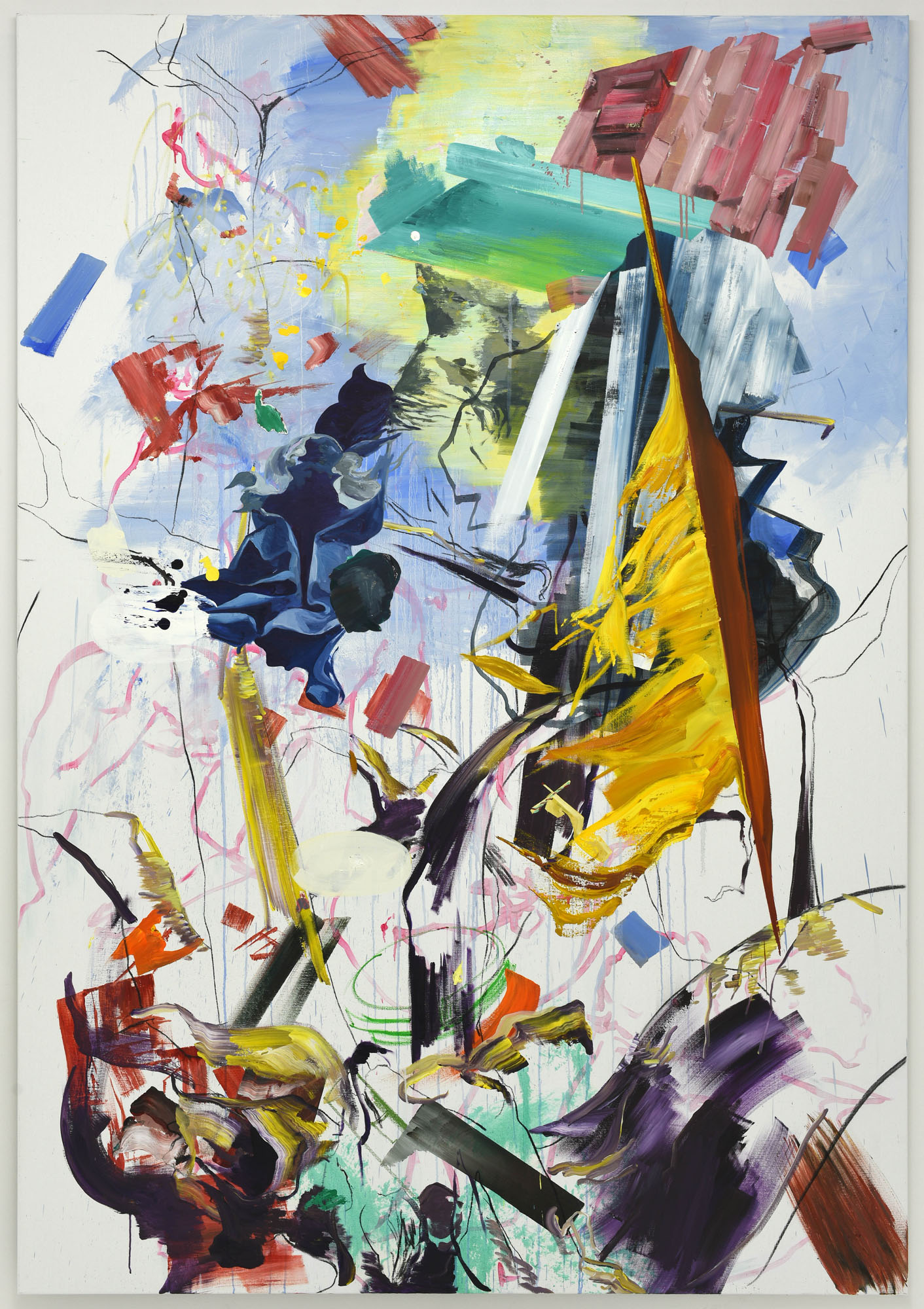
Daphne's Request P05, 2019, oilpaint and mixed media on canvas, 250 x 175 cm, 12.750€

Zwik/Zwerm P01, 2019, oilpaint on canvas, 120 x 150 cm, 6.300€
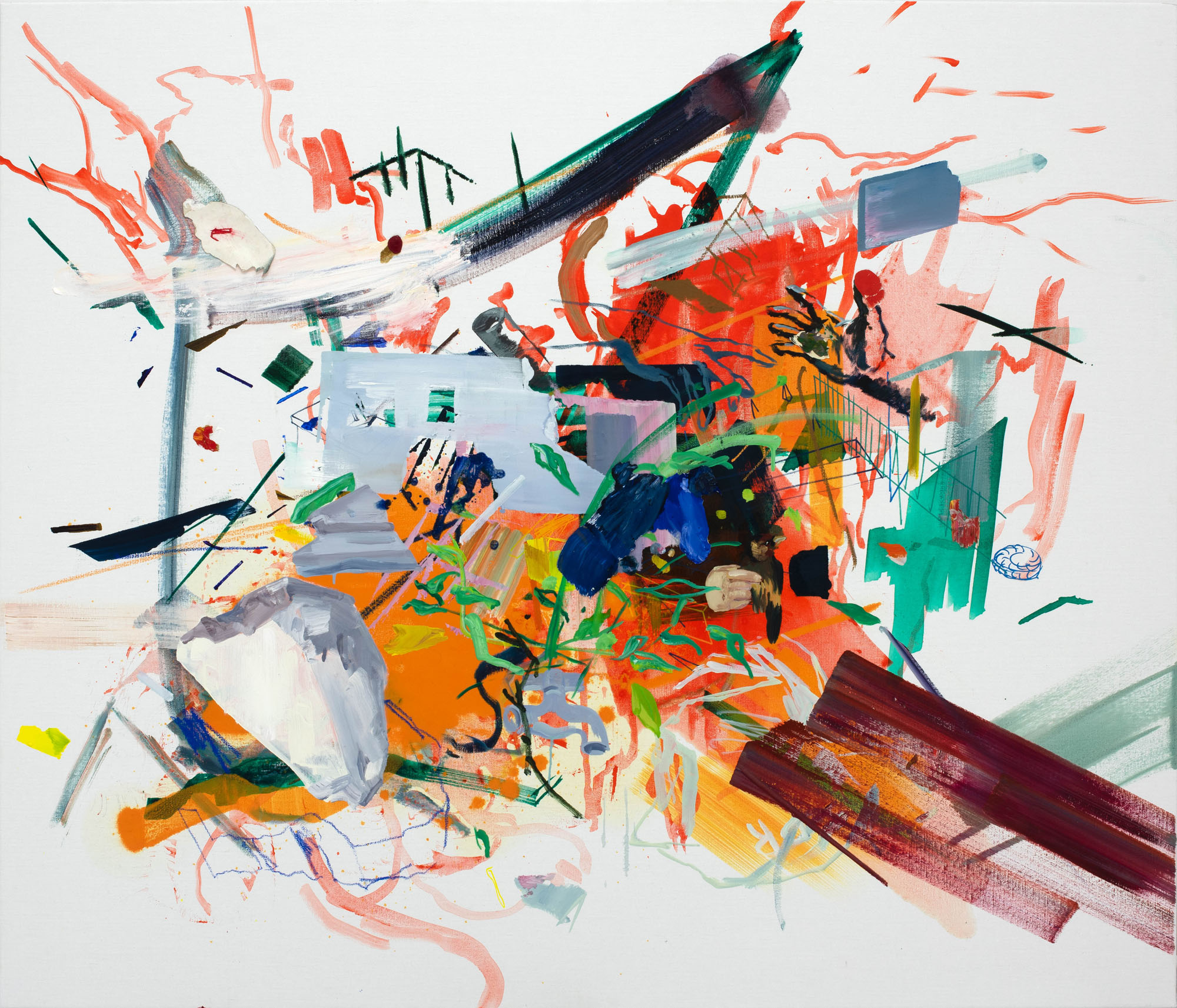
Appendix P03, 2019, oilpaint on canvas, 120 x 140 cm, 7.800€, reserved until 03.11.2020
Zwik/Zwerm P04, 2019, oilpaint on canvas, 120 x 150 cm, 6.600€
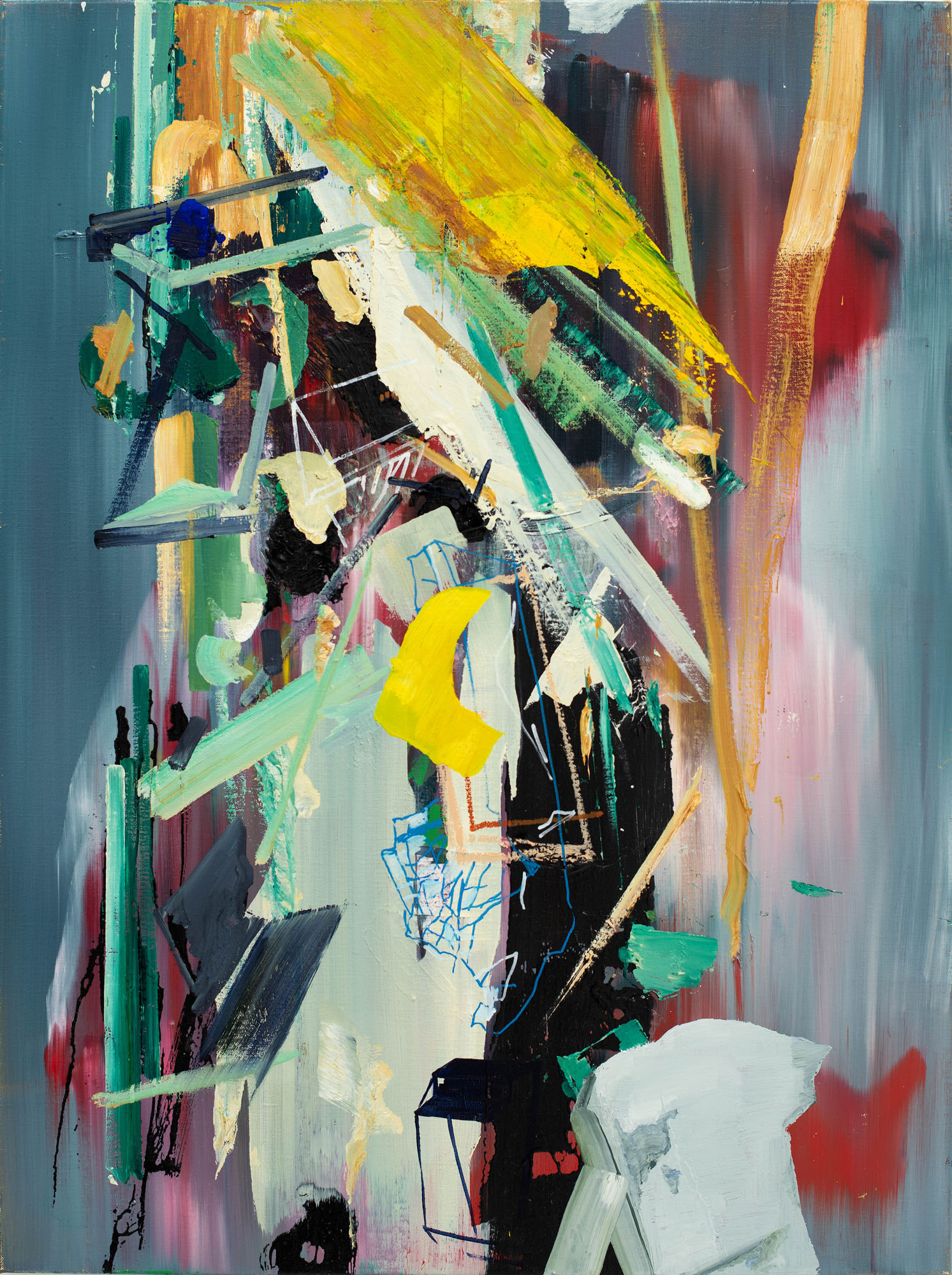
Daphnes Request P02, 2019, oilpaint on canvas, 80 x 60 cm, 4.200 €

Aberratie P 03 [Spot], 2019, 90 x 90 cm, oilpaint on canvas, 5.400 €
2018

Daphne's Request P03, 2019, oil and mixed media on canvas, 140 x 110 cm, 7.500€
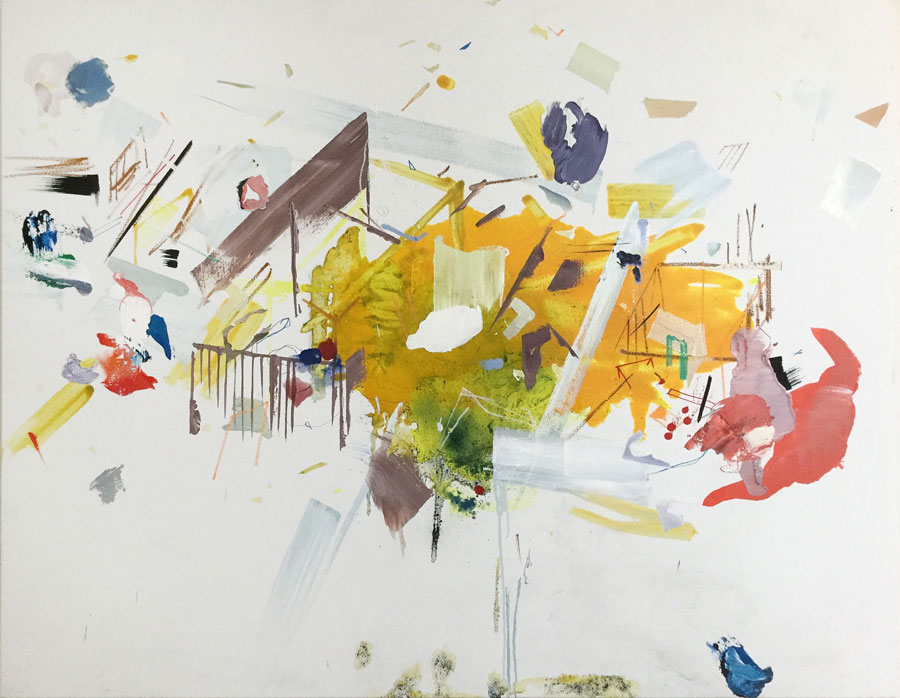
Interpuncties P46, 2018, oil and mixed media on canvas, 110 x 140 cm, 7.500 €

Interpuncties P40, 2018, oilpaint and mixed media on canvas, 120 x 90 cm, 6.300 €
Art Brussels 2018
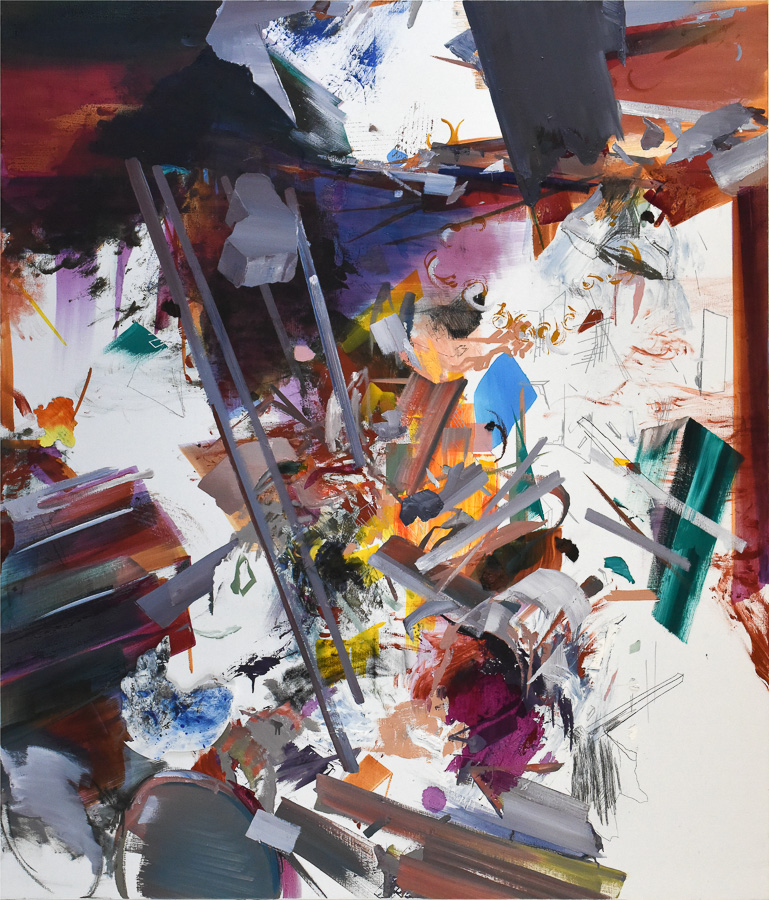
Le corps disloqué P15 (Donetsk 2), 2018, oil and mixed media on canvas, 180 x 155 cm, 9.900 €
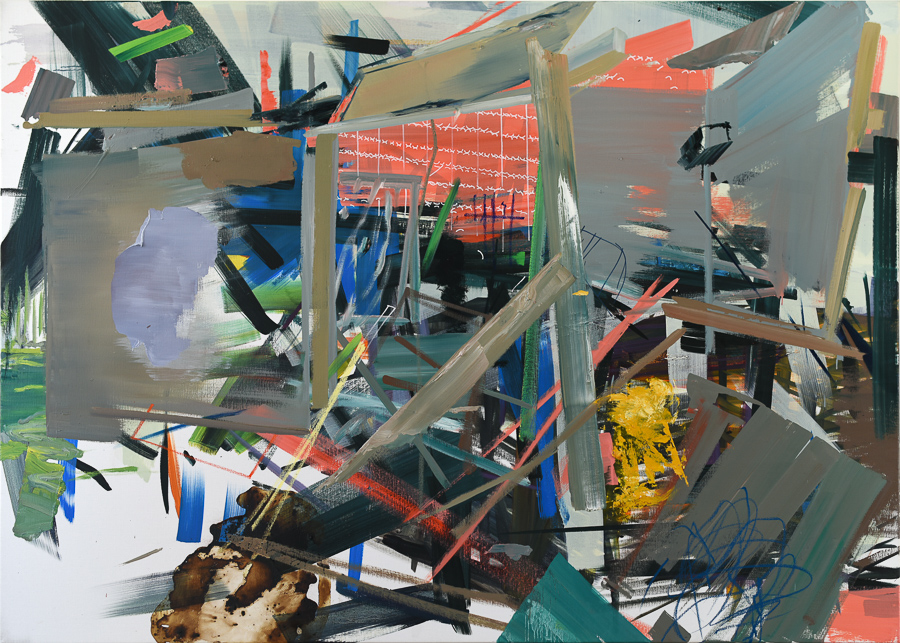
Le corps disloqué P13 (Maelbeek 3), 2018, oil and mixed media on canvas, 120 x 165 cm, 8.500 €
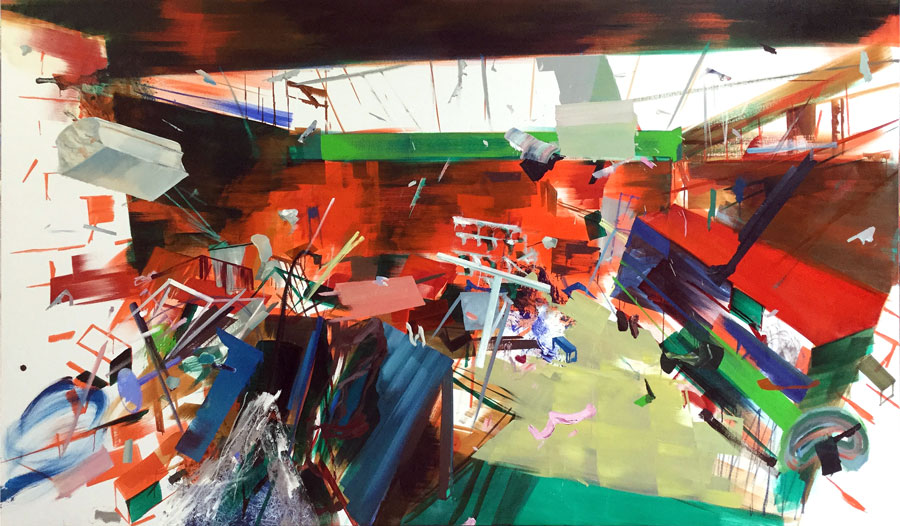
Le corps disloqué P16 (Donetsk 3), 2018, oil and mixed media on canvas, 160 x 270 cm, 12.900 €
Art Brussels 2017
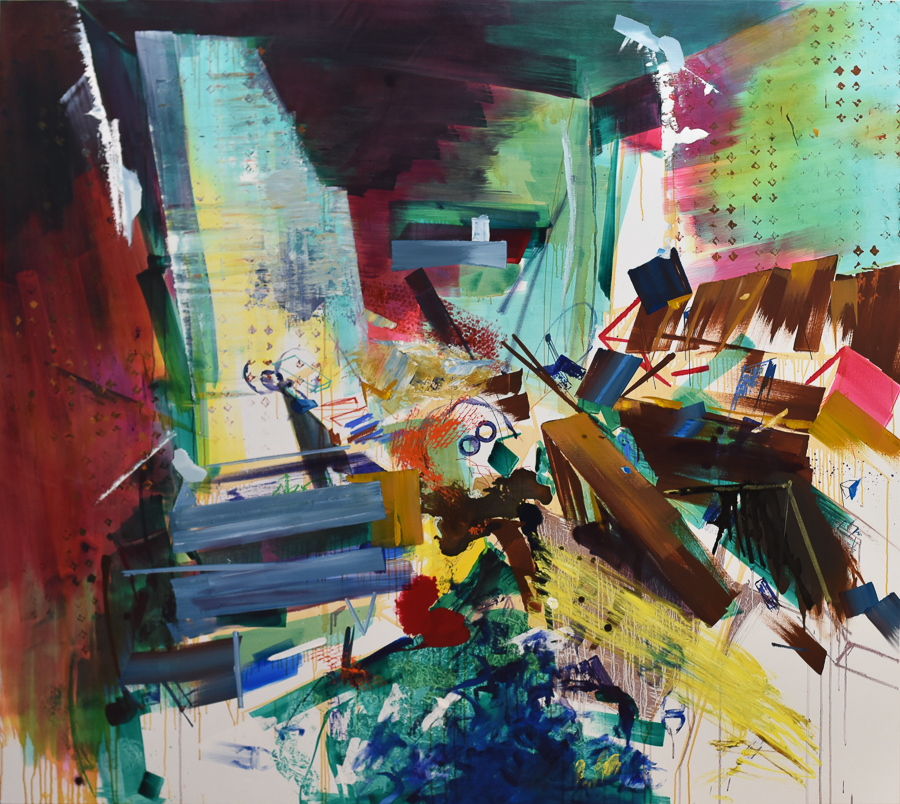
Le corps disloqué, P12, 2017, oil and mixed media on canvas, 180 x 200 cm, 11.400 €
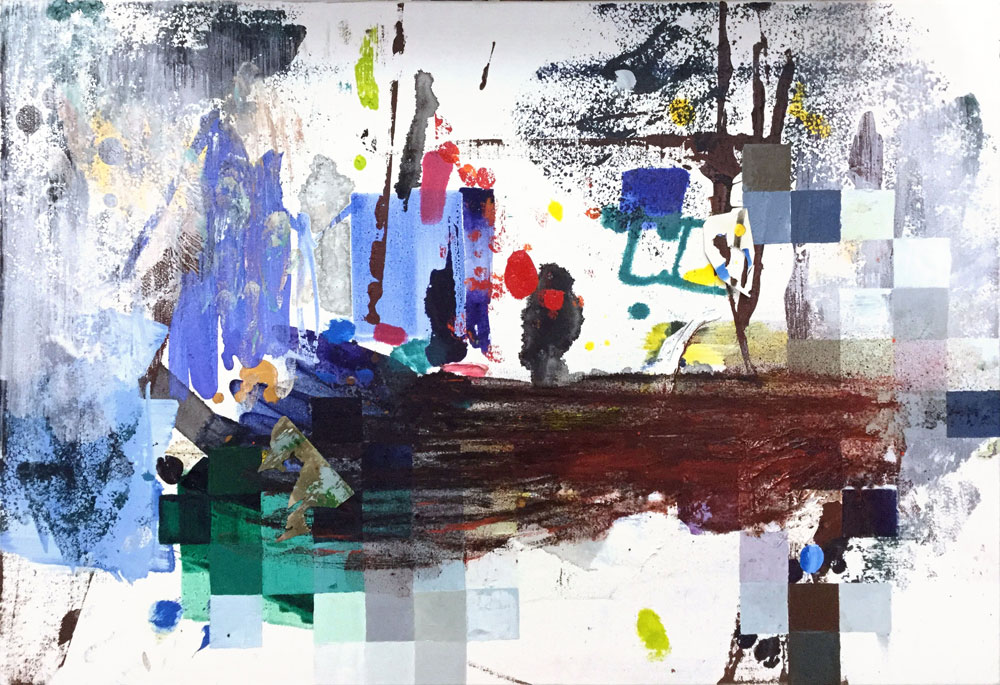
Servitude de Vue III, P10, 2017, oil and mixed media on canvas, 60 x 85 cm, 4.350 €
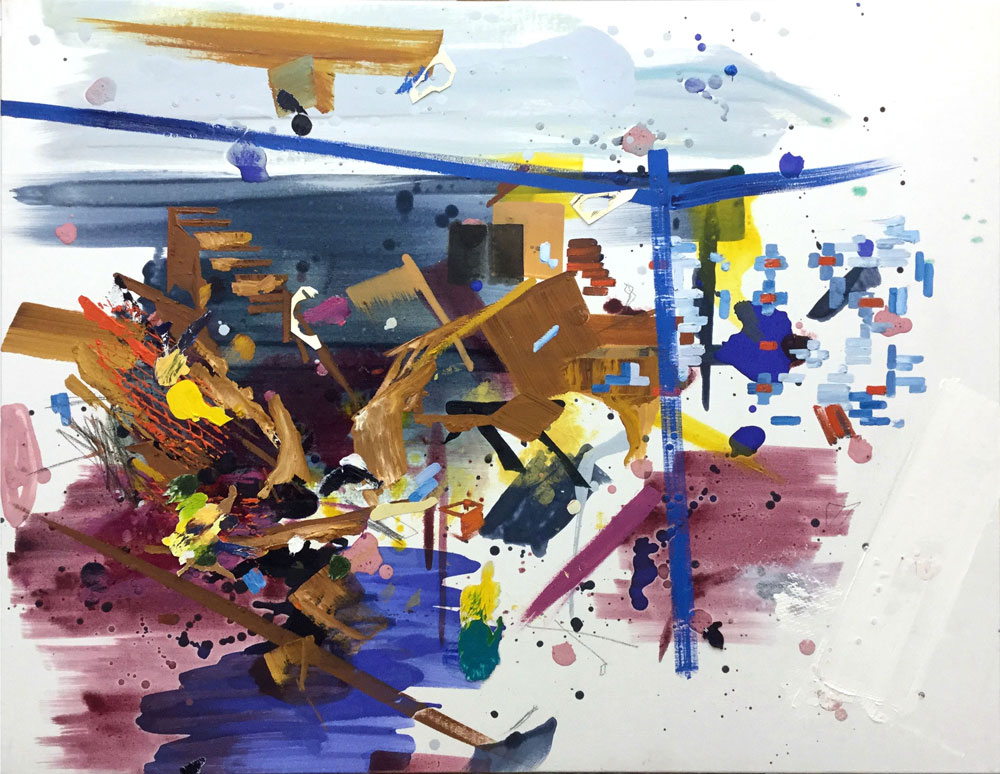
Servitude de Vue III, P11, 2017,oil and mixed media on canvas, 85 x 110 cm, 5.850 €
Effervescent | galerie Transit | 5.2 - 5.3.2017
Voor haar vijfde solotentoonstelling in galerie Transit zijn de schilderijen van Virginie Bailly zo dynamisch dat ze wel lijken te bewegen. De vele verschillende elementen in het doek, agglomeraten van penseelstreken en verfvlekken, schijnen bijna het volgende moment een andere gestalte aan te zullen nemen.
Ze bezitten een efemeer karakter net als de overblijfselen die na de wekelijkse markt, in de buurt van de woonplaats van Bailly bij een Brusselse industriewijk, over de straat verspreid liggen. Deze elementen vormen toevallige kleine composities die bijna onmiddellijk erna een andere structuur kunnen aannemen. Op grond van dit veranderingspotentieel vertonen veel van de werken van Bailly, vooral de reeks Interpuncties, een grote gelijkenis met de schilderkunst van Cy Twombly. Schijnbaar toevallig maar toch met vaste hand plaatst de kunstenares haar penseelstreken op het doek, maar naast de beschilderde partijen spelen de opengelaten ruimten een even grote rol. Ook dat herinnert ons aan Twombly.
In haar recentste werken laat de kunstenares zich inspireren door de oude meesters. De interpuncties van Giambattista Tiepolo in zijn plafondfresco's vormen bijvoorbeeld een uitgangspunt voor haar werk Interpuncties P34. Voor Bailly is het bijzonder interessant hoe Tiepolo eilandachtige figurengroepen afwisselt met grote lege ruimten en zo op meesterlijke wijze het beeldend vlak construeert en de lichtinval beheerst.
Bailly bouwt haar schilderij op rond een felgeel vlak door kleine elementen, talrijke korte, brede penseelstreken, die zij veelvoudig en talrijk naast elkaar plaatst, te verspreiden. Voor een ander werk, Interpuncties P36 [Tohoku], ontleent ze haar dynamiek aan een kruisafname van Pieter Paul Rubens waar de diagonalen en de bewegingsrichting voor inspiratie zorgen.
Even belangrijk voor de schilderkunst van Bailly zijn de hedendaagse visuele bronnen. Ze baseert zich bijvoorbeeld op beelden van de zware verwoestingen door de orkaan Matthew in 2016 aangericht in Haïti en het is, zoals zo vaak in de eerdere werken van Bailly het geval was, dat die indrukken niet onmiddellijk regelrecht op het doek terechtkomen maar dat het eerder de atmosfeer en de stemmingen zijn die worden weergegeven.
De mediabeelden van de orkaan inspireren de kunstenares, zoals de kruisafnames van Rubens, niet enkel qua vormgeving maar eveneens qua inhoudelijkheid. De christelijke iconografie toont het dode lichaam van Jezus, na een lange lijdensweg, met hoopvolle verwachting in de gelaatstrekken, deze hoop zal later worden ingelost als Hij uit de dood opstaat. Dit aspect van vertrouwen is ook terug te vinden op de foto's van de door de orkaan aangerichte verwoesting van een hele streek omdat, ondanks alle zorgen en vernieling, de medemensen er zijn om de slachtoffers te helpen een nieuw leven op te bouwen. Dit zijn beelden die de spanningstoestand van een overgang weergeven, daar waar net nog leed en verdriet was kan men hoopvol betere tijden verwachten en kan er iets nieuws ontstaan. Angst overwinnen is zoveel als een politieke daad stellen. Dit moment brengt Bailly over in haar schilderijen.
Een foto van de aanslag in het Brusselse metrostation Maalbeek op 22 maart 2016, vormt de achtergrond van het werk, Le corps disloqué P10 (Maelbeek 1). Deze foto toont het metrostel en de lichamen van de slachtoffers die overal verspreid liggen; de lichamen zijn onherkenbaar gemaakt door pixels, verschanst achter lege vlekken. De verschrikkelijke waarheid komt aan het licht door het blootleggen van de vernielde wagon en door het verbergen van de lichamen door blinde vlekken. De blinde vlekken vinden een parallel in de schilderijen. Zo toont Bailly aan dat abstracte schilderkunst niet van politiek verstoken moet zijn. [Nina Schedlmayer, januari 2017]
FOR ENGLISH: scroll down

Interpuncties P31, 2016, oil and mixed media on canvas, 275 x 160 cm, 13.000 €
For her fifth solo exhibition at Gallery Transit, Virginie Bailly presents paintings that are so dynamic that they seem to move. The various elements on the canvas, agglomerates of brushstrokes and paint splotches, look as if they are on the verge of taking on a different shape.
They possess an ephemeral character, like the remains that are left scattered across the street after the weekly market near Bailly's residence in a Brussels industrial area. These elements form casual little compositions able to adopt a different structure within moments. This strong transformative potential, evident in many of the works of Bailly, especially in the series entitled Interpuncties [Punctuations], makes that her works exhibit strong similarities with the paintings of Cy Twombly. Seemingly casual yet with a steady hand, the artist places her brush strokes on the canvas, yet the left open spaces play as important a role as the painted areas. This also, is reminiscent of Twombly.
In her latest work, the artist finds inspiration in the old masters. The punctuations of Giovanni Battista Tiepolo in his ceiling frescoes, for example, are a starting point for her work Interpuncties P34. Bailly is particularly interested in how Tiepolo alternates island-like groups of figures with large empty spaces, thereby masterfully constructing the visual plane and controlling the light.
Bailly composes her painting around a bright yellow plane through a scattering of numerous, juxtaposed small elements, made up of short, broad brush strokes. In another work, Interpuncties P36 [Tohoku], the dynamic composition is derived from a descent of the cross by Peter Paul Rubens whose diagonals and direction of movement formed a direct inspiration.
Equally important in Bailly's painting are contemporary visual sources. She finds inspiration, for example, in images of the heavy devastation caused by Hurricane Matthew in 2016 in Haiti yet, as was also often the case in her earlier works, these impressions are not immediately put to the canvas, but are rather depicted through atmospheres and moods.
The media images of the hurricane inspire the artist, just like Rubens' descent of the cross, not just compositionally but also in terms of content. The Christian iconography shows the dead body of Jesus, after a long agony, with hopeful expectation in his facial expression, a hope which will later be fulfilled when he rises from the dead. This aspect of hopefulness can also be found in the photos of the devastation caused by the hurricane across an entire region because, despite all the worries and destruction, there are fellow men helping the victims to build up a new life. These are images that depict the state of tension of a transition; places of suffering and grief where there is hope for something better, the start of something new. To overcome fear is to commit a political act. This is the moment that Bailly expresses in her paintings.
A picture of the attack in the Brussels metro station Maalbeek on March 22, 2016, forms the backdrop of the work, Le corps disloqué P10 (Maelbeek 1). This picture shows the subway car and the bodies of the victims scattered everywhere; the bodies have been rendered unrecognizable by means of pixilation, they are hidden behind empty spots. The terrible truth comes to light by uncovering the wrecked railcar and hiding the bodies behind blind spots. The blind spots find a parallel in the paintings. Bailly, in this way, makes clear that abstract painting need not be devoid of politics. [Nina Schedlmayer, Januari 2017]
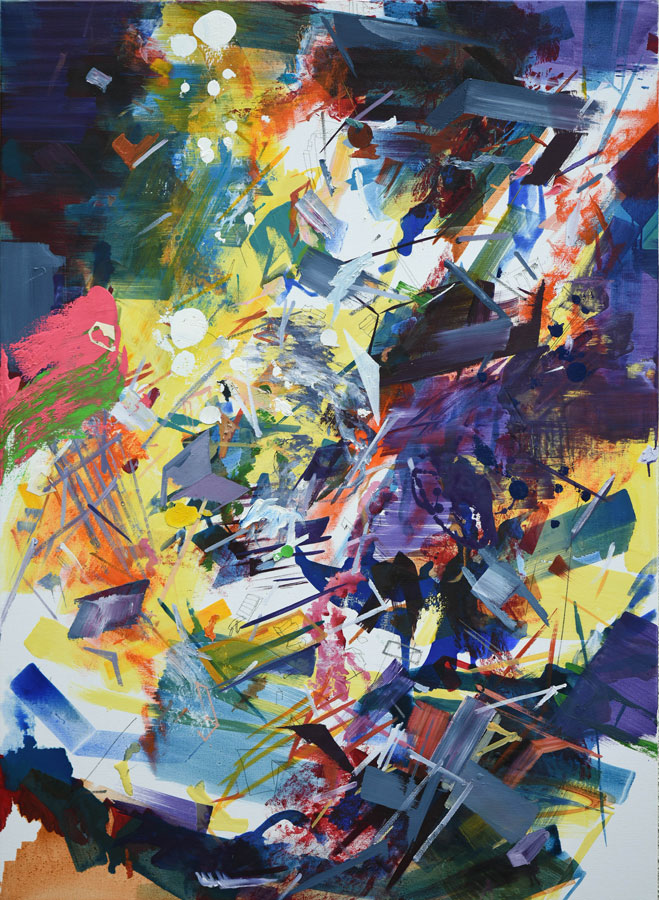
Interpuncties, P32 [Matthew], 2016, oil and mixed media on canvas, 110 x 150 cm, 7.800 €
Go to: Interpuncties | Impromptu | Vide-Plein | Le Corps Disloqué | Servitude de Vue
Servitude de Vue | 2015 - 2016
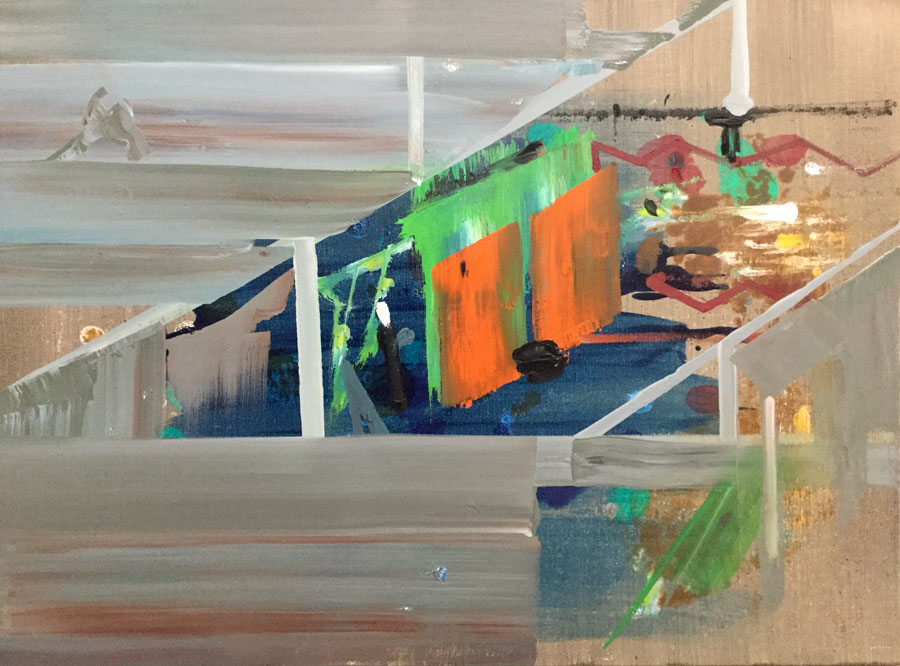
Servitude de vue II, P01, 2015, oil on canvas, 60 x 70 cm, 4.200 €

Servitude de vue II, P03, 2015, oil on canvas, 60 x 70 cm, 4.200 €
Go to: Interpuncties | Impromptu | Vide-Plein | Le Corps Disloqué | Servitude de Vue
Interpuncties | 2013 - 2014 - 2015
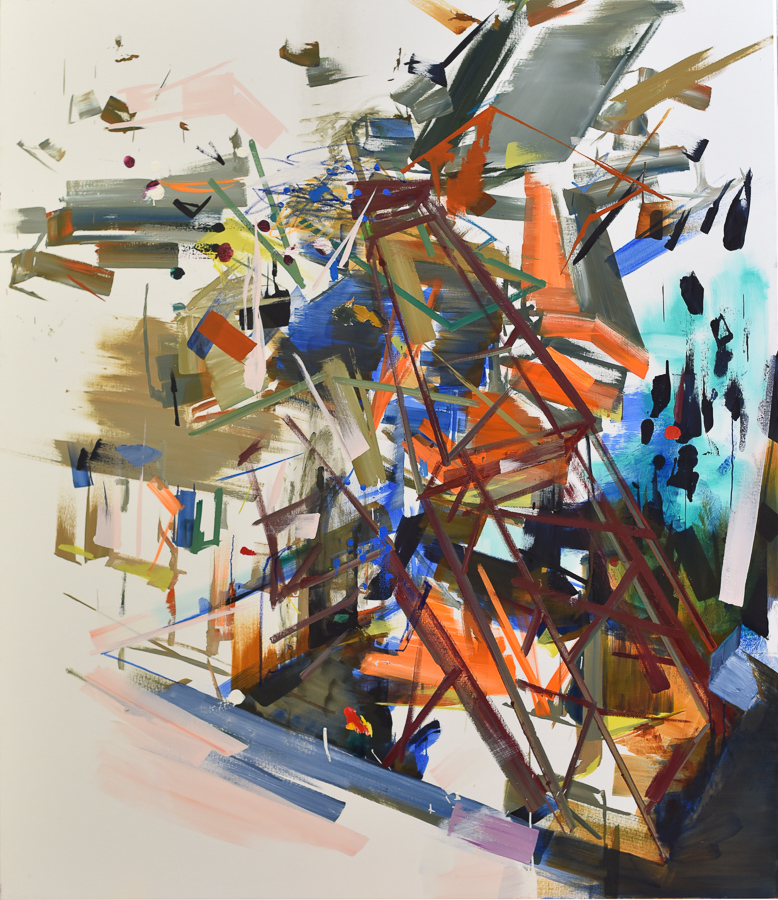
Interpuncties, P21,2015,oil and mixed media on canvas, 200 x 170 cm, 2015, 11.100 €
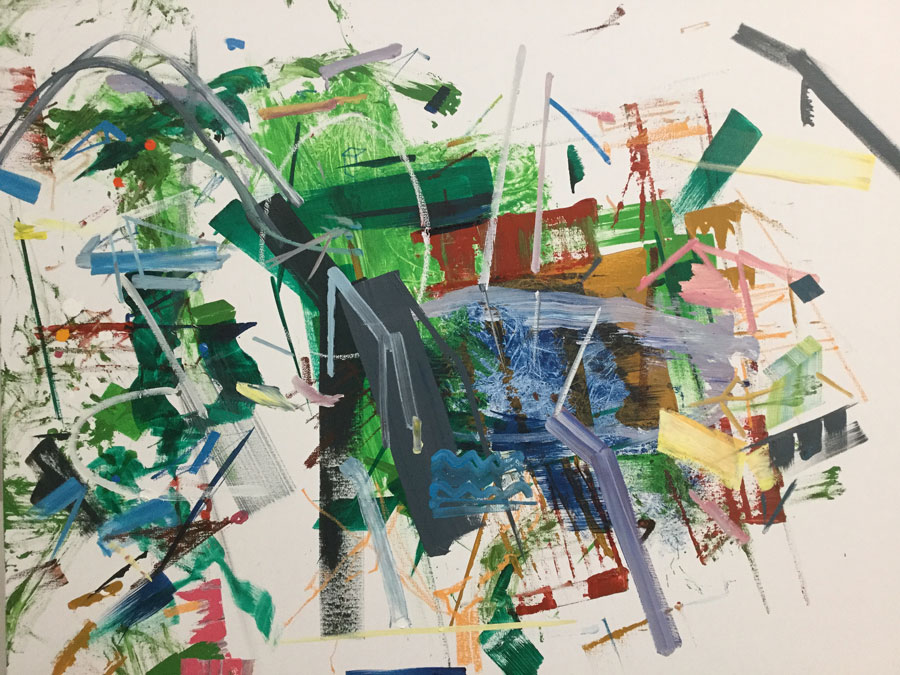
Interpuncties P27, 2015, oil on canvas, 115 x 130cm, 7.350 €
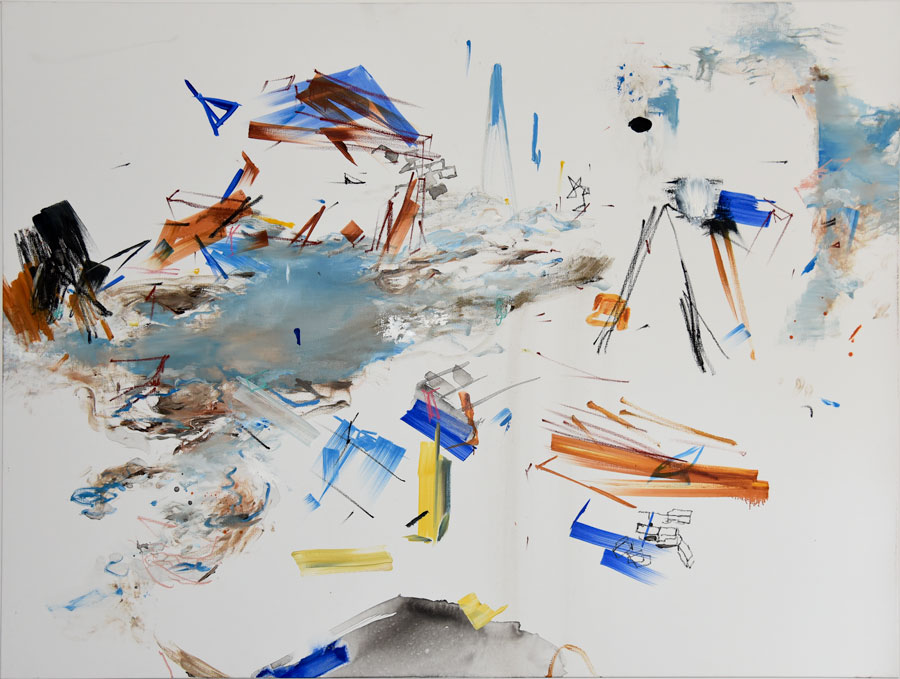
Interpuncties P15, 2015, oil on canvas, 140 x 190 cm, 9.900 €
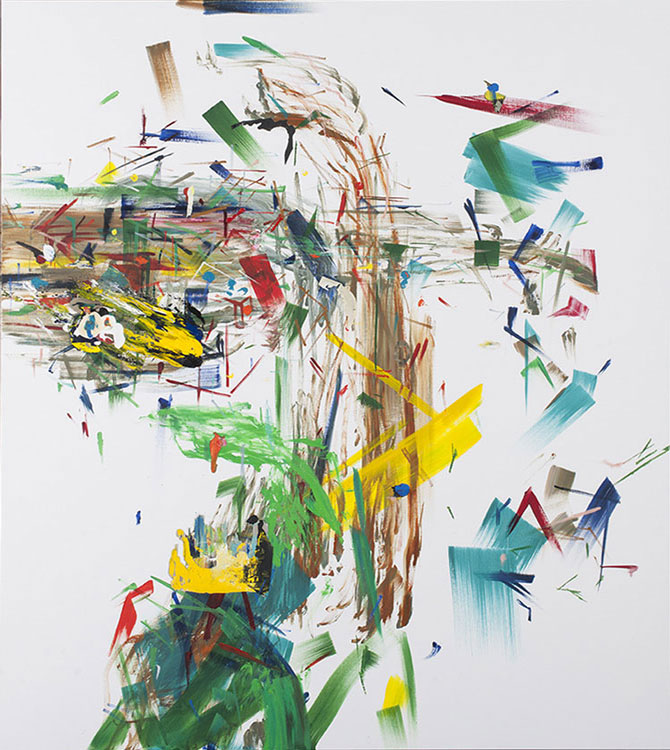
Interpuncties P01, 2014, oil on canvas & collage, 160 x 180 cm
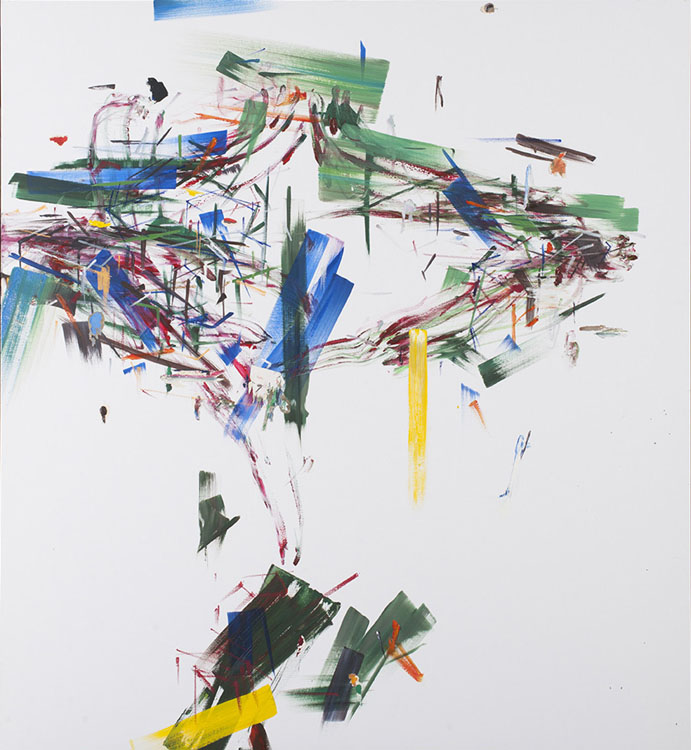
Interpuncties P02, 2014, oil on canvas & collage, 170 x 185 cm
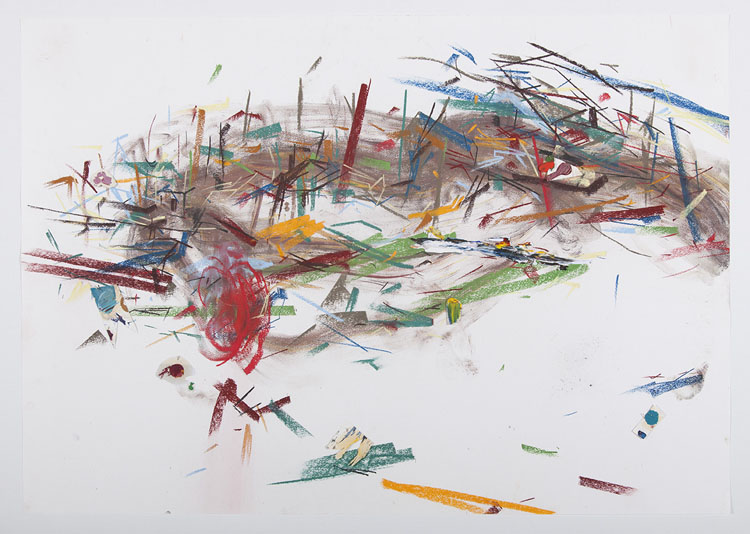
Interpuncties D09, 2013, pastel and mixed media on paper, 70 x 100 cm

Interpuncties D11, 2013, pastel and mixed media on paper, 70 x 100 cm
Go to: Interpuncties | Impromptu | Vide-Plein | Le Corps Disloqué | Servitude de Vue
Impromptu | 2012 - 2014
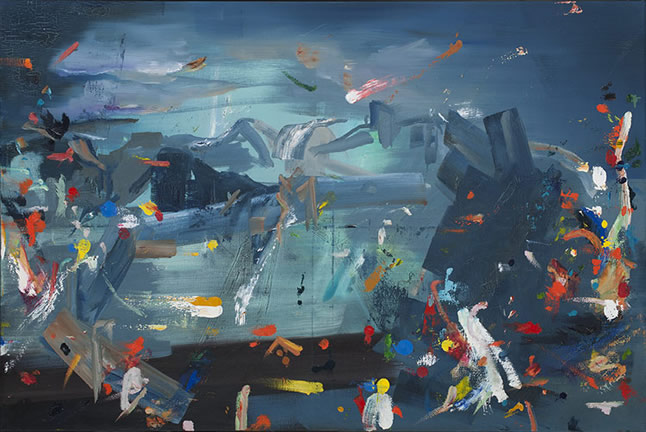
Impromptu P10 (EPontormo), 2013, oil on canvas, 80 x 120 cm

Impromptu P12, 2013, oil on canvas, 140 x 190 cm
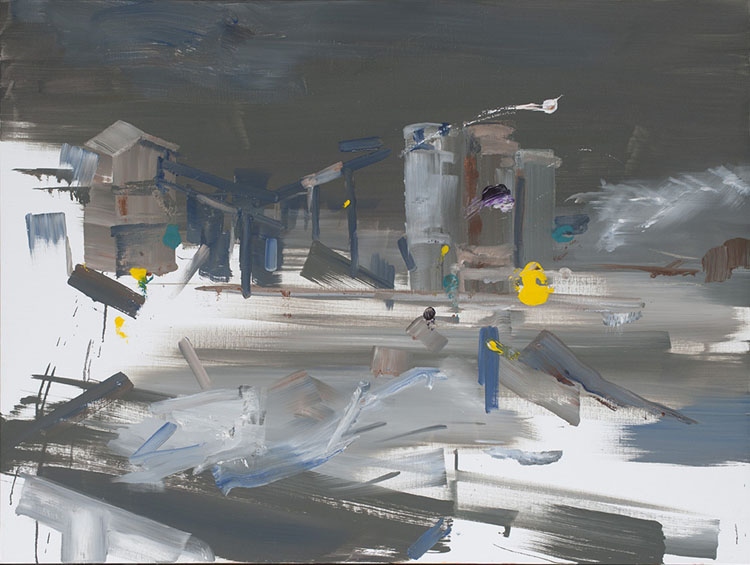
Impromptu P16, 2013, oil on canvas, 90 x 120 cm
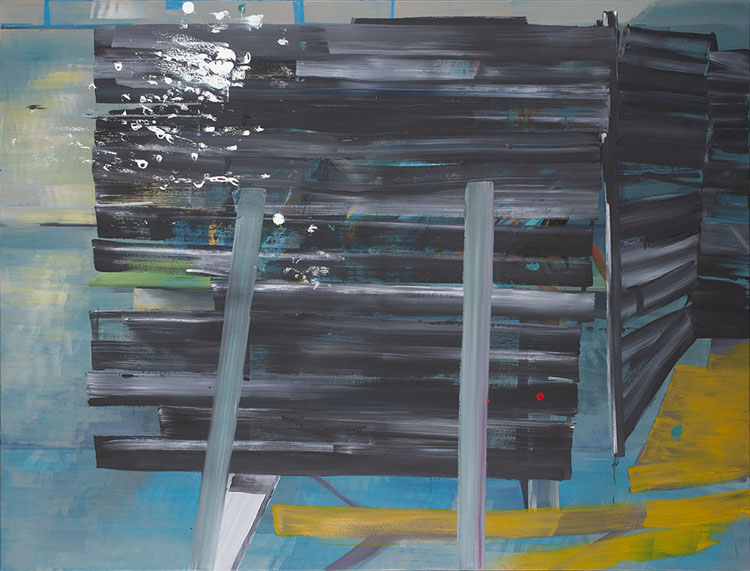
Impromptu P17, 2013, oil on canvas, 160 x 210 cm
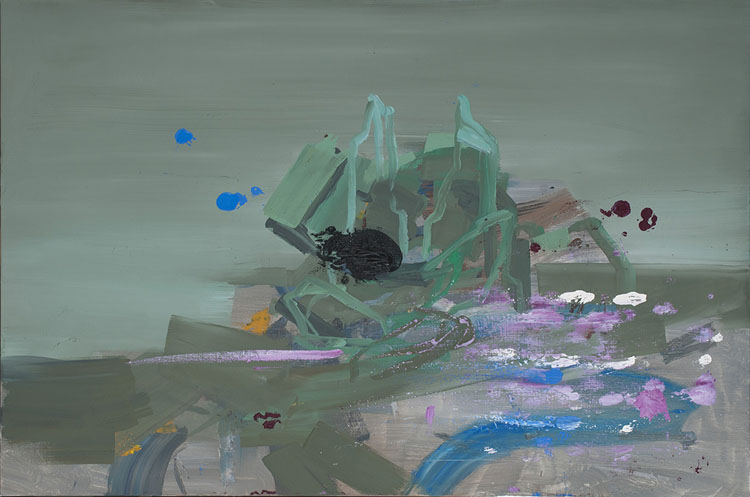
Impromptu P18, 2013, oil on canvas, 80 x 120 cm

Impromptu P03, 2013, oil on canvas, 90 x 120 cm
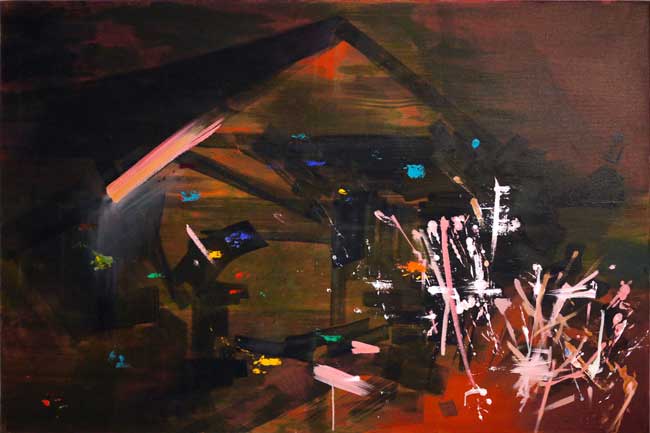
Impromptu P01, 2012, oil on canvas, 80 x 120 cm
Go to: Interpuncties | Impromptu | Vide-Plein | Le Corps Disloqué | Servitude de Vue
Le Corps Disloqué | 2012 -2013 - 2015

Le Corps Disloque P07, 2013-2015, oil on canvas, 160 x 250 cm

Le corps disloqué P05, 2012, oil on canvas,190 x 250 cm

Le corps disloqué P01, 2012, oil on canvas, 120 x 170 cm
Vide-Plein | 2009 - 2013
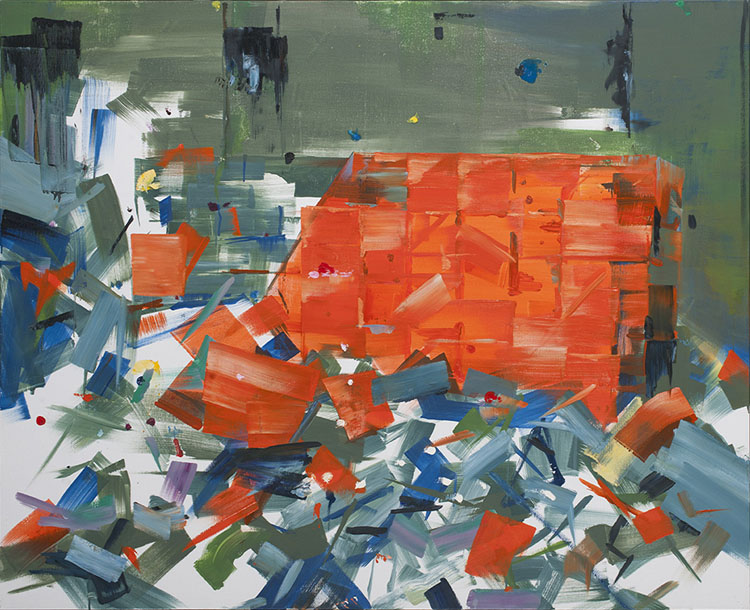
Vide-Plein III- P11, 2011-2013, oil and pastel on canvas, 130 x 160 cm
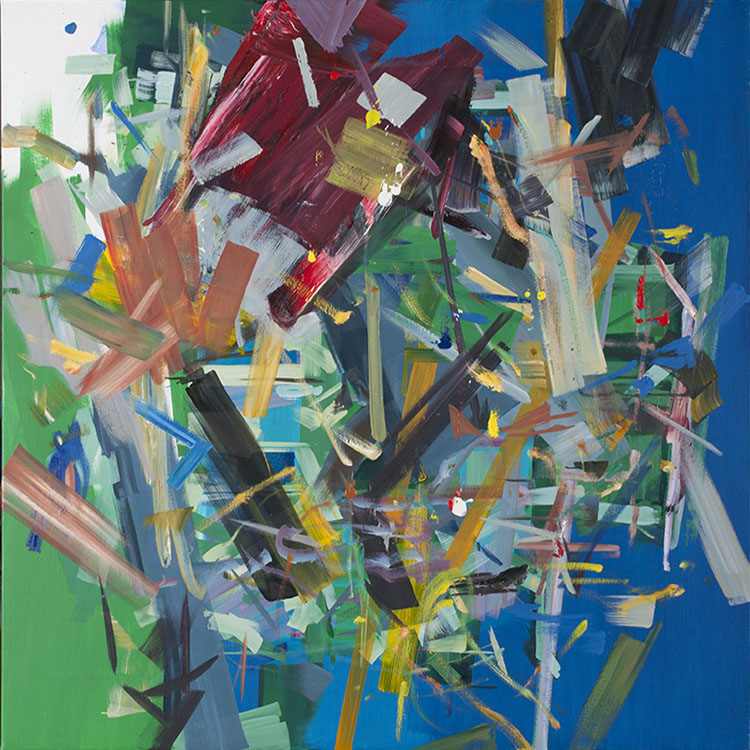
Vide-Plein-III-P24, 2013, oil on canvas, 130 x 130 cm
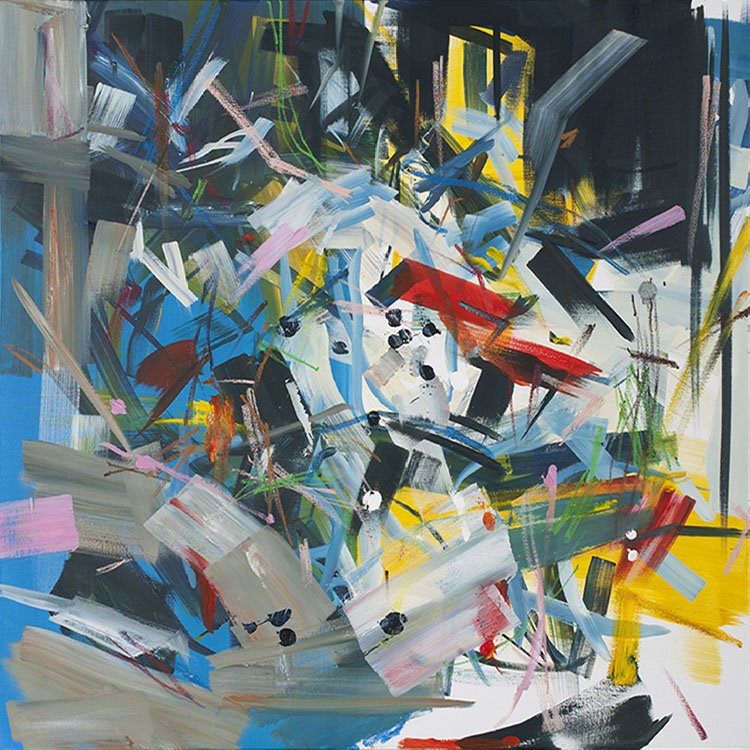
VidePlein III-P26, 2013-2014, oil and pastel on canvas, 120 x 120 cm
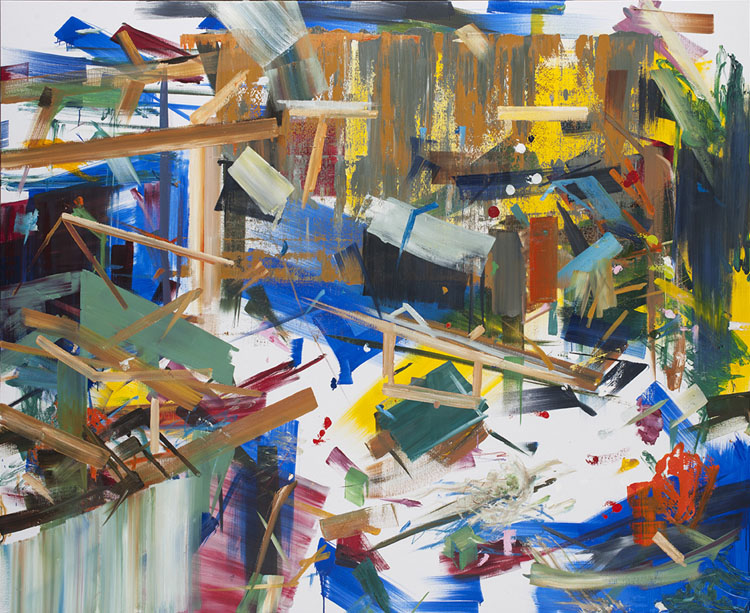
Vide Plein III-P28, 2014, oil on canvas, 180 x 220 cm
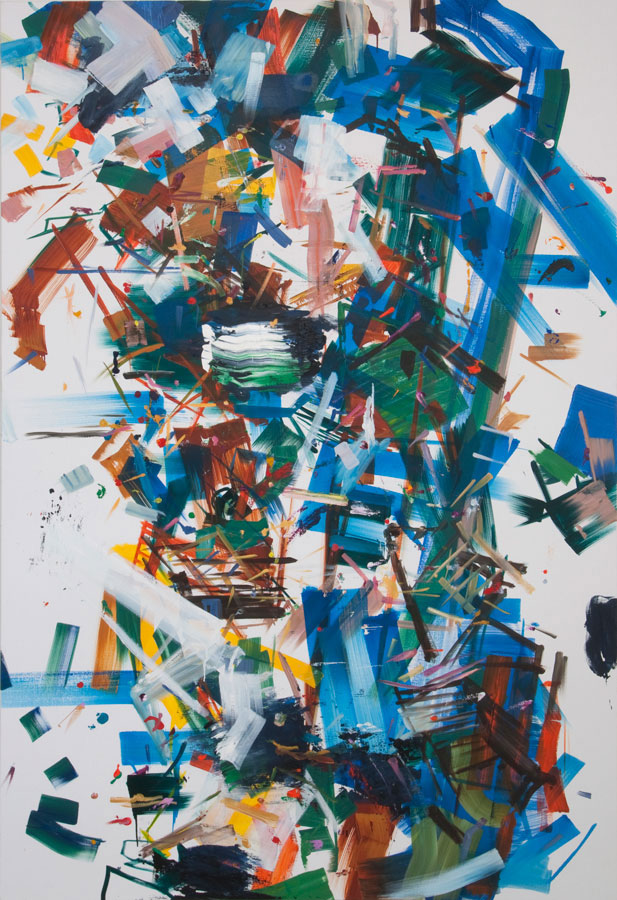
Vide-Plein III-P20, 2013, oil on canvas, 220 x 150 cm
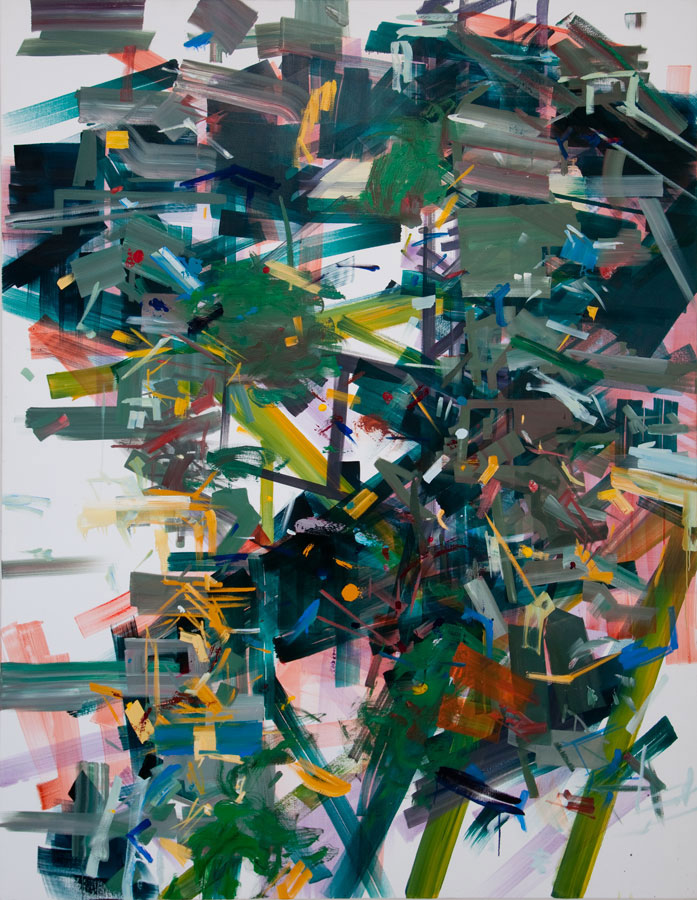
Vide-Plein III-P19, 2013, oil on canvas, 220 x 170 cm
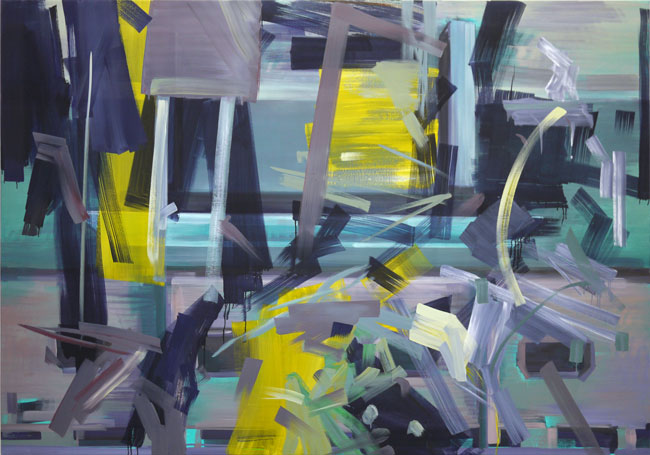
Vide-Plein III- P17 [Landscape on Table revisited], 2007-2012, oil on canvas, 140 x 200 cm

Vide-Plein II-P02-02, 2010, oil on canvas, 100 x 100 cm
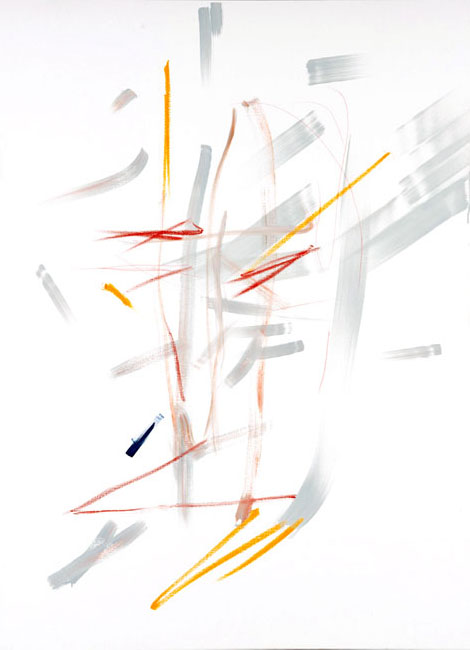
Vide Plein I -P 01-05, 2010, oil on canvas, 165 x 120 cm
Go to: Interpuncties | Impromptu | Vide-Plein | Le Corps Disloqué | Servitude de Vue
De logica van de mierenhoop 2011, galerie Transit 2011
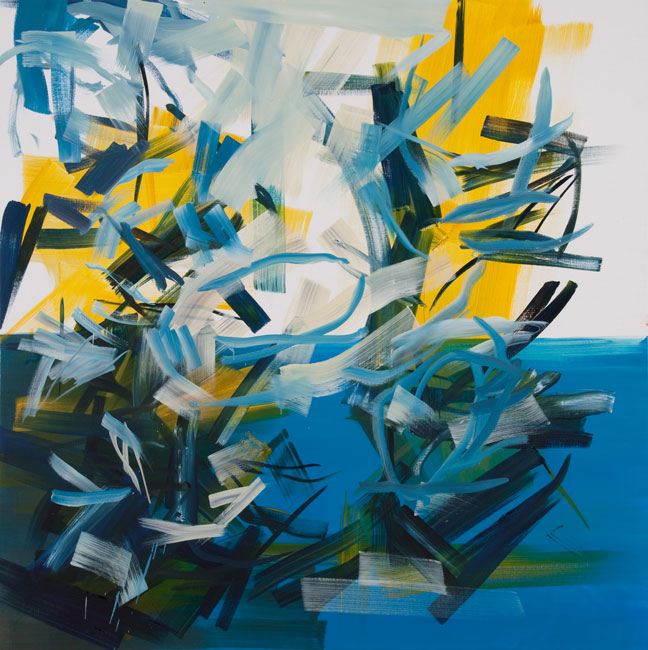
Vide Plein III- P12, 2011, oil on canvas, 120 x 120 cm
click here for more painting from the exhibtion 'De logica van de mierenhoop'
Vide et plein, Docks Art Fair, Lyon 14 - 20 September 2009
Vide et plein 00-01 & 00-07, 2009, pastel on paper, 50 x 33 cm
Virginie Bailly | Servitude de vue I | 2012
Nieuwe pastelreeks | New series of pastel drawings | Nouveaux pastels sur papier | 65 x 50 cm
Landscape on Table, Galerie Transit, 1. March - 12. April 2009
Voor haar tweede tentoonstelling in Transit, vond Virginie Bailly inspiratie in de vermaarde Chinese tuinen. In deze tuinen staat de reflectie over de natuur in relatie met de mens centraal. Deze reflecties worden verzinnebeeld in een ommuurd stukje natuur opgedeeld in verschillende tuinkamers. Als een huis zonder dak vormen afwisseling, verrassing en verwondering de rode draad in deze gecomprimeerde verbeelding van het landschap, die de ambitie heeft het landschap zelf te zijn.
Al wandelend doorheen deze tuinkamers krijgt men voortdurend een andere kijk waarin micro- en macroschaal tegenover elkaar worden uitgespeeld. Zo zijn er ook kleine kamers met wit gekalkte muren en een azuurblauw ‘plafond’ waar op de bakstenen vloer een wit marmeren tafel staat met daarin een geënsceneerd landschap met enkele rotsblokken op de tafel. Deze opgestelde rotsformaties waar geen sprietje groen aan de pas komt, verhalen over rust, harmonie en sereniteit. De monumentaliteit van het gecreëerde beeld wordt gedragen door de tafel die veeleer als een sokkel naar voren treedt.
Een ander aspect binnen deze landschapscreaties fascineerde Bailly in het bijzonder. In iedere kamer geeft de rotsformatie een andere blik op hetzelfde thema. Vreemde uitgesneden openingen in de muren geven verschillende perspektieven. In haar schilderijen wordt de rots dan ook dubbelzinnig uitgebeeld: soms vast als een onveranderlijk beeld, soms met een schildertoets die dichtbij het vluchtige, het tijdelijke staat.
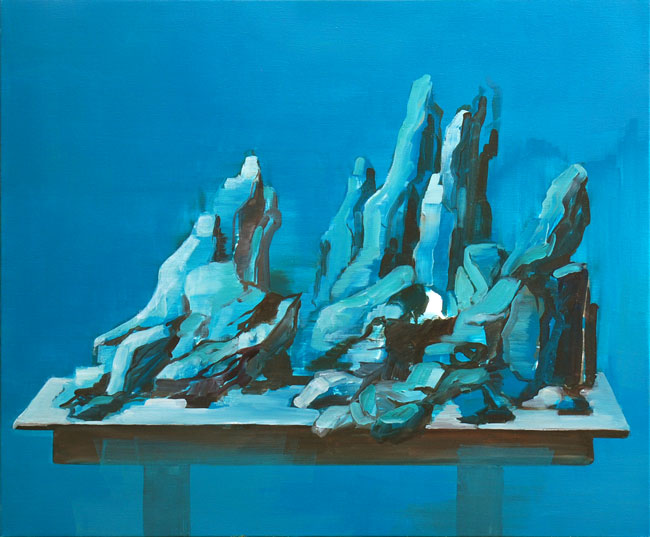
Landscape on Table II, 2008, oil on canvas, 100 x 120 cm
Tout vide, tout plain, voila le tableau [i.s.m. Floris Dehantschutter], video-installation with two screens, 2009
![Tout vide, tout plain, voila le tableau [i.s.m. Floris Dehantschutter]](SelectedWorks/2009/VB_ToutVideToutPlain_installationview.jpg)
Health and Care - De Bond, Brugge, February 2009
For the ‘Health and Care’ series I took inspiration from the odd pieces of fitness apparatus that stand on one of the beaches at Xiamen along the coast. These pink, blue and mint-green devices are set one after another in a row a hundred metres long. They stand out in the foreground like lost sculptures, while in the background a view of the sea unfolds that is only sporadically interrupted by a palm tree. I translated this mysterious scene into a series of paintings in which the structures figure as independent entities in the landscape and where the settings balance on the boundary between plane, abstraction and space. [Virgine Bailly]
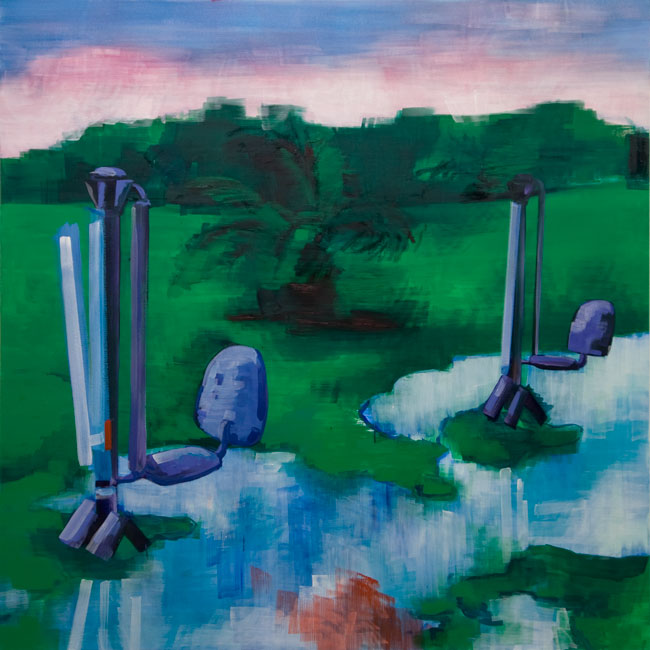

Health and Care I and III, 2008, oil on canvas, 180 x 180 cm

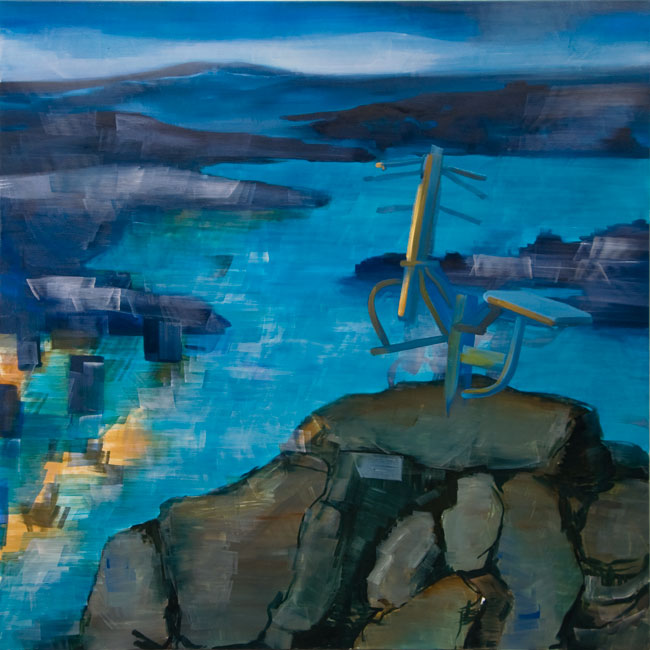
Health and Care IV, 2008, oil on canvas, 180 x 150 cm & Health and Care VI, 2008, oil on canvas, 180 x 180 cm
Voor de reeks 'Chinascape' inspireerde ik mij op de bevreemdende fitnesstoestellen die langs de kuststrook staan op één van de stranden in Xiamen. Deze roze, blauwe of mintgroene toestellen staan in een honderd meter lange rij achter elkaar geplaatst. Als verloren sculpturen pronken ze op het voorplan, op de achtergrond waaiert er een zeezicht open slechts enkele keren onderbroken door een palmboom. Dit mysterieuze tafereel vertaalde ik in een serie schilderijen waarin deze structuren figureren als autonome entiteiten binnen het landschap en waarbij de contexten balanceren op de grens tussen vlak, abstractie en ruimte. [Virgine Bailly]
Videostills from the exhibition in De Bond, Brugge, 2009

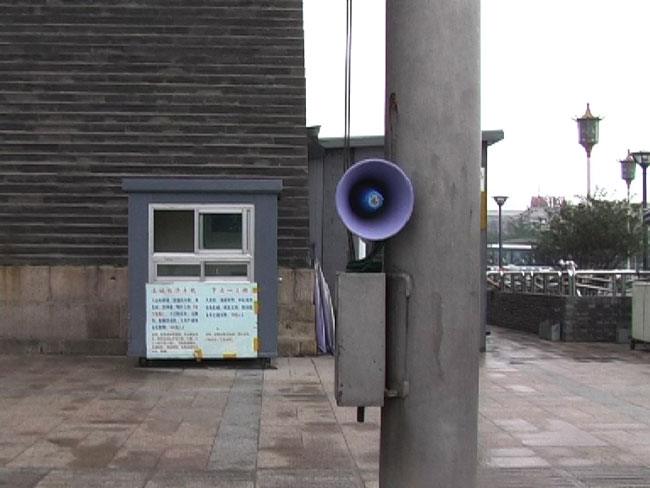


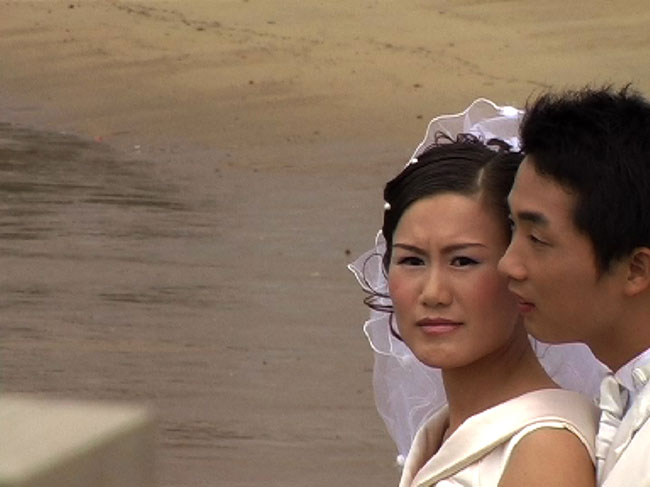
Troubler les lointains - series 3, Art Brussels 2007 April 2007 & Pushing the Canvas, De Garage Mechelen, May 2007
Troubler les lointains, 2007, oil on canvas, 120 x 160 cm
Troubler les lointains - series 2, Transit January 2007
"In de late negentiende en twintigste eeuw werden schilders
bang om ruimte te representeren of er een illusie van te creëren.
Het leek er immers sterk op dat fotografen of filmmakers dat voortaan beter
konden. Door hun angst moesten de schilders niettemin veel nadenken over
de ruimte, en terwijl ze haar probeerden te vergeten, werden ze goed geïnformeerde
gasten die soms meer van haar bleken af te weten dan de gastvrouw zelve.
(...)
Iets dat wordt bekeken, zit altijd ergens tussen beeld en ruimte in. Architectuur
bijvoorbeeld zit ook tussen beeld en ruimte in. De meeste dingen, eigenlijk,
zolang we twee ogen hebben, tenminste, en die ogen in een lichaam passen dat
ruimte nodig heeft om in te leven.
(...)
Virginie Bailly zorgt met oude schildertechnieken voor diepte en illusie in haar
schilderijen, en ze daagt de materialiteit van haar installaties uit door er
enorme tools van te maken voor het kaderen van een beeld: een fragment
van een landschap, een foto, een film of – terug naar het begin – een
schilderij. Haar verlangen om een ruimte in een beeld te kaderen, en andersom,
heeft geleid tot een soort klassieke kijk op de huidige beeldcultuur: beeld en
ruimte verschansen zich niet in excessen, maar tonen dat ze niet zonder elkaar
kunnen."
Fragmenten uit: Lars Kwakkenbos, 'Between Image and Space (as Most Things Are)', ongepubliceerd.
2002 - 2006
“In the late 19th and 20th century painters became afraid of its
ability to represent a space that lay outside the canvas and to create
an illusion of it. Photographers or filmmakers seemed to have better tools
to do so. Yet that fear experienced by painters, forced them to think a
lot about space, and while trying to forget it they became well-informed
guests, knowing more than their host.
(...)
A thing we see is always somewhere in between image and space. Architecture for
exemple is also in between image and space. Most things are, as long as we have
two eyes, at least, and those two eyes fit in a body that needs space to live
in.
(...)
By applying old painting techniques Virginie Bailly creates depth and illusion
in her paintings and she challenges the materiality of her installations by turning
them into enormous tools for the framing of images: a fragment of a landscape,
a photograph, a film or – back to the beginning – a painting. Her
desire to frame a space in an image and an image in a space has led to a kind
of classic view on today's visual culture: image and space do not hide in excesses,
but reveal they cannot exist without each other.”
Excerpts from: Lars Kwakkenbos, ‘Between Image and Space (as Most Things
Are)’, unpublished.
